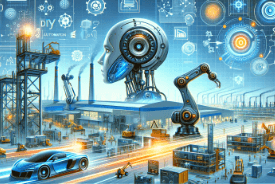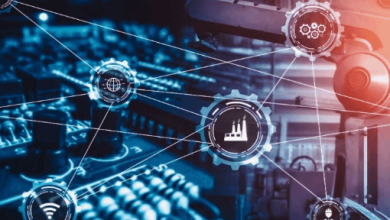Top Trends in Automation in 2024

Introduction
Automation continues to revolutionize industries, bringing increased efficiency, cost savings, and innovation. In 2024, automation is set to take even greater strides with advancements in artificial intelligence (AI), machine learning, and robotics. This article explores the top trends in automation for 2024, highlighting the latest technologies and their impacts on various sectors.
AI-Driven Automation
Overview
Artificial intelligence (AI) is at the forefront of the automation revolution, enabling machines to perform tasks that traditionally required human intelligence. From natural language processing to machine vision, AI-driven automation is transforming industries by increasing efficiency, reducing errors, and enabling new capabilities.
Key Technologies
- Natural Language Processing (NLP): Enhances machine understanding of human language, improving customer service through chatbots and virtual assistants.
- Machine Vision: Powers automated quality inspection in manufacturing, ensuring products meet high standards.
- Predictive Analytics: Uses AI to analyze data and predict future outcomes, aiding in decision-making processes.
Industry Applications
- Manufacturing: AI-driven robots perform repetitive tasks with high precision, reducing production times and costs.
- Healthcare: AI assists in diagnostics, patient monitoring, and administrative tasks, improving patient care and operational efficiency.
- Finance: AI automates trading, fraud detection, and customer service, enhancing financial operations and security.
Hyperautomation
Definition and Scope
Hyperautomation refers to the use of advanced technologies, including AI and machine learning, to automate processes across an organization. It goes beyond individual task automation, aiming for end-to-end process automation.
Key Components
- Robotic Process Automation (RPA): Automates repetitive, rule-based tasks.
- Artificial Intelligence (AI): Enhances decision-making capabilities and enables intelligent automation.
- Machine Learning (ML): Improves processes through continuous learning and adaptation.
Benefits
- Increased Efficiency: Hyperautomation streamlines processes, reducing time and effort.
- Cost Savings: Reduces operational costs by minimizing manual labor and errors.
- Enhanced Accuracy: Automates complex processes with high precision, reducing the likelihood of mistakes.
Robotic Process Automation (RPA)
Current State
Robotic Process Automation (RPA) involves using software robots to automate repetitive, rule-based tasks. As of 2024, RPA technology has matured, offering robust solutions for various industries.
Innovations
- Intelligent RPA: Combines RPA with AI to handle more complex tasks and improve decision-making.
- Scalability: Modern RPA solutions are highly scalable, capable of handling large volumes of transactions and tasks.
- Integration: Enhanced integration capabilities with other technologies and systems.
Case Studies
- Finance: Automating invoicing, accounts payable, and reconciliation processes, reducing processing times and errors.
- Healthcare: Streamlining patient data management, appointment scheduling, and billing processes.
- Retail: Managing inventory, processing orders, and handling customer queries through automated systems.
Intelligent Process Automation (IPA)
Combining AI and RPA
Intelligent Process Automation (IPA) integrates AI technologies with RPA to create more sophisticated automation solutions. This combination allows for the automation of complex, cognitive tasks that require decision-making and learning.
Key Benefits
- Enhanced Decision-Making: AI improves the ability of automated systems to make informed decisions.
- Process Optimization: Continuously learns and adapts to optimize processes over time.
- Improved Customer Experience: Provides personalized and efficient customer interactions through advanced automation.
Implementation Challenges
- Complexity: Integrating AI with RPA requires careful planning and expertise.
- Data Quality: High-quality data is essential for effective AI training and performance.
- Change Management: Organizations need to manage the transition to IPA, including employee training and process redesign.
Edge Computing in Automation
What is Edge Computing?
Edge computing refers to the processing of data closer to the source of data generation, rather than relying on centralized cloud servers. This approach reduces latency and bandwidth usage, making it ideal for automation applications that require real-time processing.
Benefits for Automation
- Reduced Latency: Ensures faster response times for real-time applications.
- Bandwidth Efficiency: Minimizes the amount of data transmitted to central servers, reducing costs.
- Enhanced Security: Processes data locally, reducing exposure to potential security breaches.
Use Cases
- Manufacturing: Real-time monitoring and control of production lines, improving efficiency and reducing downtime.
- Healthcare: Immediate processing of patient data for faster diagnostics and treatment decisions.
- Retail: Real-time inventory management and customer analytics to enhance shopping experiences.
Autonomous Vehicles and Drones
Recent Developments
Autonomous vehicles and drones have seen significant advancements, with improved AI algorithms, sensors, and communication technologies enabling greater autonomy and reliability.
Industry Applications
- Logistics and Delivery: Autonomous trucks and drones are revolutionizing the logistics industry by providing efficient, contactless delivery services.
- Agriculture: Drones and autonomous tractors assist in precision farming, improving crop management and yield.
- Surveillance and Security: Drones provide real-time monitoring and surveillance, enhancing security operations.
Regulatory Challenges
- Safety Standards: Ensuring autonomous systems meet stringent safety standards is critical for widespread adoption.
- Privacy Concerns: Addressing privacy issues related to the use of autonomous vehicles and drones.
- Regulatory Frameworks: Developing comprehensive regulatory frameworks to govern the deployment and operation of autonomous systems.
Industrial IoT (IIoT) Integration
Overview of IIoT
The Industrial Internet of Things (IIoT) involves connecting industrial devices and systems through the internet to collect and analyze data, improving operational efficiency and decision-making.
Automation in Manufacturing
- Predictive Maintenance: IIoT sensors monitor equipment health, predicting failures before they occur and reducing downtime.
- Process Optimization: Real-time data analytics optimize manufacturing processes, increasing productivity and reducing waste.
- Supply Chain Management: IIoT enhances visibility and coordination across the supply chain, improving overall efficiency.
Future Prospects
- AI Integration: Combining IIoT with AI for advanced analytics and automation.
- Edge Computing: Leveraging edge computing for real-time data processing and decision-making.
- Sustainability: Using IIoT to monitor and reduce environmental impact in manufacturing processes.
Smart Manufacturing
Key Trends
Smart manufacturing leverages advanced technologies like AI, IoT, and robotics to create highly efficient, flexible, and intelligent production systems.
Benefits
- Increased Productivity: Automates repetitive tasks and optimizes processes, boosting productivity.
- Flexibility: Adapts to changing market demands and production requirements.
- Quality Control: Enhances quality control through real-time monitoring and automated inspections.
Case Studies
- Automotive Industry: Smart factories producing vehicles with high precision and efficiency.
- Electronics Manufacturing: Automated assembly lines for complex electronic devices.
- Pharmaceuticals: Smart manufacturing ensuring compliance with stringent regulatory standards.
Digital Twins
Concept and Applications
Digital twins are virtual replicas of physical assets or systems, used to simulate, analyze, and optimize performance. They play a crucial role in automation by providing real-time insights and predictive analytics.
Benefits for Automation
- Predictive Maintenance: Identifies potential issues before they cause downtime.
- Process Optimization: Simulates different scenarios to find the most efficient processes.
- Cost Savings: Reduces operational costs by optimizing resource usage and maintenance schedules.
Industry Examples
- Aerospace: Digital twins used for aircraft design, maintenance, and performance optimization.
- Manufacturing: Virtual models of production lines to improve efficiency and reduce downtime.
- Energy Sector: Simulating and optimizing power generation and distribution systems.
AI and Machine Learning in Cybersecurity
Importance in Automation
As automation increases, so does the need for robust cybersecurity measures. AI and machine learning are essential for detecting and mitigating cyber threats in automated systems.
Key Technologies
- Anomaly Detection: Identifies unusual patterns that may indicate cyber attacks.
- Threat Intelligence: Uses AI to analyze and respond to emerging threats in real-time.
- Automated Response: Deploys automated defenses to neutralize threats quickly and effectively.
Case Studies
- Finance: AI-driven cybersecurity protecting financial transactions and customer data.
- Healthcare: Safeguarding patient information and medical devices from cyber attacks.
- Manufacturing: Preventing cyber threats that could disrupt production processes.
Human-Robot Collaboration
Current Trends
Human-robot collaboration (HRC) involves humans and robots working together in shared environments. Advances in AI and robotics have made HRC more feasible and effective.
Benefits
- Increased Productivity: Combines human creativity and problem-solving with robotic efficiency.
- Safety: Robots handle dangerous tasks, reducing workplace accidents.
- Flexibility: Robots assist with various tasks, enhancing workforce adaptability.
Future Outlook
- Enhanced AI: Improving robot intelligence for more effective collaboration.
- User-Friendly Interfaces: Developing intuitive interfaces for seamless human-robot interaction.
- Expanding Applications: HRC in diverse sectors, from manufacturing to healthcare.
Cloud Automation
Overview
Cloud automation involves using cloud-based services and tools to automate IT tasks and processes. It provides scalability, flexibility, and cost-efficiency for businesses.
Key Technologies
- Infrastructure as Code (IaC): Automates infrastructure provisioning and management.
- Serverless Computing: Automates backend infrastructure, allowing developers to focus on code.
- AI and ML Integration: Enhances cloud automation with intelligent decision-making and optimization.
Benefits and Challenges
- Scalability: Easily scales up or down based on demand.
- Cost Efficiency: Reduces costs by automating resource management.
- Security: Ensuring robust security measures in automated cloud environments.
Automation in Healthcare
Key Trends
Automation is transforming healthcare by improving efficiency, reducing costs, and enhancing patient care. Key trends include AI-driven diagnostics, robotic surgery, and automated administrative tasks.
Benefits
- Improved Patient Care: Automation enhances diagnostic accuracy and treatment efficiency.
- Cost Savings: Reduces operational costs through streamlined processes.
- Operational Efficiency: Automates administrative tasks, freeing up healthcare professionals to focus on patient care.
Case Studies
- AI Diagnostics: AI systems assisting in diagnosing diseases with high accuracy.
- Robotic Surgery: Robots performing precise surgical procedures with minimal invasiveness.
- Telemedicine: Automated systems supporting remote patient monitoring and consultations.
AI in Customer Service Automation
Chatbots and Virtual Assistants
AI-powered chatbots and virtual assistants are revolutionizing customer service by providing instant, accurate, and personalized responses to customer inquiries.
Benefits
- 24/7 Availability: Provides round-the-clock customer support.
- Cost Efficiency: Reduces the need for large customer service teams.
- Personalization: Delivers personalized experiences based on customer data and interactions.
Future Trends
- Advanced NLP: Improving natural language understanding for more accurate and human-like interactions.
- Integration with Other Systems: Seamlessly integrating with CRM and other business systems for enhanced service.
- Proactive Customer Service: Predicting customer needs and providing solutions before issues arise.
Predictive Maintenance
Overview
Predictive maintenance uses AI and IoT technologies to predict equipment failures before they occur, allowing for timely maintenance and reducing downtime.
Key Technologies
- IoT Sensors: Collect real-time data on equipment health and performance.
- AI Algorithms: Analyze data to predict potential failures and maintenance needs.
- Cloud Computing: Stores and processes large volumes of data for predictive analytics.
Industry Applications
- Manufacturing: Predictive maintenance for machinery, reducing downtime and maintenance costs.
- Energy Sector: Monitoring and maintaining power generation and distribution equipment.
- Transportation: Ensuring the reliability of vehicles and infrastructure through predictive maintenance.
Automation in Supply Chain Management
Key Trends
Automation is transforming supply chain management by improving efficiency, reducing costs, and enhancing visibility. Key trends include AI-driven demand forecasting, automated warehouses, and autonomous delivery.
Benefits
- Efficiency: Automates repetitive tasks, speeding up supply chain operations.
- Cost Savings: Reduces labor and operational costs.
- Visibility: Provides real-time visibility into supply chain operations, enhancing decision-making.
Case Studies
- Retail: Automated warehouses and AI-driven demand forecasting improving inventory management.
- Manufacturing: Streamlined supply chain operations through automation and real-time data analytics.
- Logistics: Autonomous vehicles and drones enhancing delivery efficiency.
Automation in Retail
Current Trends
Automation in retail is enhancing customer experiences, improving inventory management, and reducing operational costs. Key trends include automated checkout systems, AI-driven product recommendations, and robotic inventory management.
Benefits
- Enhanced Customer Experience: Provides personalized shopping experiences through AI-driven recommendations.
- Operational Efficiency: Automates inventory management and checkout processes, reducing wait times and errors.
- Cost Savings: Reduces labor costs through automated systems.
Future Prospects
- AI Integration: Advanced AI algorithms providing deeper insights and personalized experiences.
- Robotics: Increased use of robots for inventory management and customer service.
- Omnichannel Automation: Seamless integration of online and offline retail experiences through automation.
See also: Understanding the Benefits of Smart Auto Recycling in Canada
Ethical Considerations in Automation
Overview
As automation technologies advance, ethical considerations become increasingly important. These include issues related to job displacement, data privacy, and decision-making transparency.
Key Concerns
- Job Displacement: Automation replacing human jobs, leading to unemployment and social issues.
- Data Privacy: Ensuring the privacy and security of data collected and processed by automated systems.
- Decision-Making Transparency: Making AI-driven decisions transparent and understandable to build trust.
Mitigation Strategies
- Reskilling Programs: Providing training and education to help workers transition to new roles.
- Robust Privacy Measures: Implementing strong data protection policies and technologies.
- Transparent AI: Developing AI systems that provide clear explanations for their decisions.
Future of Work with Automation
Impact on Jobs
Automation is reshaping the future of work, impacting job roles, skills requirements, and workplace dynamics. While some jobs may be displaced, new opportunities are also emerging.
Required Skills
- Technical Skills: Proficiency in AI, machine learning, and robotics.
- Analytical Skills: Ability to analyze and interpret data for decision-making.
- Adaptability: Flexibility to adapt to new technologies and job roles.
Adaptation Strategies
- Continuous Learning: Emphasizing lifelong learning and upskilling.
- Collaboration: Encouraging collaboration between humans and machines.
- Policy Support: Implementing policies to support workers in transitioning to new roles.
Regulatory and Compliance Issues
Overview
The rapid advancement of automation technologies raises regulatory and compliance challenges that need to be addressed to ensure safe and ethical implementation.
Key Challenges
- Safety Standards: Ensuring automated systems meet high safety standards.
- Data Protection: Complying with data protection regulations and ensuring privacy.
- Ethical AI: Developing and implementing ethical AI guidelines and practices.
Future Outlook
- Global Collaboration: Promoting international collaboration to develop comprehensive regulatory frameworks.
- Adaptive Regulations: Creating flexible regulations that can adapt to technological advancements.
- Public Awareness: Raising awareness about the benefits and risks of automation to build public trust.
FAQs
What are the key trends in automation for 2024? Key trends include AI-driven automation, hyperautomation, robotic process automation, and the integration of edge computing and IIoT.
How does hyperautomation differ from traditional automation? Hyperautomation involves end-to-end process automation using advanced technologies like AI and machine learning, whereas traditional automation focuses on automating individual tasks.
What industries are most affected by automation? Industries such as manufacturing, healthcare, finance, retail, and logistics are significantly impacted by automation.
What are the ethical considerations of automation? Ethical considerations include job displacement, data privacy, and transparency in AI decision-making.
How is AI transforming customer service automation? AI enhances customer service through chatbots and virtual assistants, providing instant, accurate, and personalized responses to customer inquiries.
What role does edge computing play in automation? Edge computing processes data closer to the source, reducing latency and bandwidth usage, which is crucial for real-time automation applications.
Conclusion
Automation in 2024 is poised to revolutionize industries with advanced technologies like AI, hyperautomation, and edge computing. These trends offer significant benefits, including increased efficiency, cost savings, and improved decision-making. However, addressing ethical considerations and regulatory challenges is crucial to ensure the responsible and sustainable implementation of automation technologies. Embracing these trends will enable organizations to stay competitive and drive innovation in the ever-evolving technological landscape.




